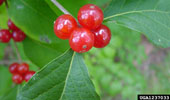“The American chestnut (Castanea dentata) was once a dominant canopy species in the Eastern Deciduous Forest. Unfortunately, the species was decimated by the chestnut blight (Cryphonectria parasitica) in the early 20th century,” say Dr. Brian McCarthy and Lauren Bizzari in the introduction to their poster on “An experimental assessment of American chestnut growth and survival on reclaimed mined lands across their native range.”
McCarthy, Associate Dean for Faculty, Graduate Studies and Research in Ohio University’s College of Arts & Science and Professor of Forest Ecology, and graduate student Bizarri presented their poster at the annual meeting of the American Chestnut Foundation, which funded their research. Over the past 30 years, the American Chestnut Foundation has helped to revive and energize efforts to restore the American chestnut, bringing this important issue to the forefront of conservation. McCarthy is on the foundation’s Board of Directors.
“To restore the species, the American Chestnut Foundation has created a backcross (BC) breeding program to hybridize blight-resistant Chinese chestnuts (Castanea mollissima) with American chestnut. Hybrid success (particularly BC3 hybrids) under field conditions will need to be assessed before these seeds can be reintroduced on a regional scale,” they say.
“Surface mines are abundant within the chestnut’s native range. Recent mine reclamation efforts in the Appalachian Region have focused on methods that encourage tree growth, such as the Forestry Reclamation Approach. Reclaimed mines could serve as possible entry points for chestnut reintroduction in the region.”
In the Spring of 2008, collaborators planted chestnut seeds on reclaimed mine lands in six Appalachian states. In the summer of 2012, four states—Kentucky, Ohio, Pennsylvania and Tennessee—were revisited to collect data. The researchers measured tree height and root collar diameter for all the surviving trees. They looked at chlorophyll content and specific leaf area for a subset of the trees. They examined vegetation cover and sampled soil. They also collected data from the National Climatic Data Center.
They were looking for answer to two questions:
- After five growing seasons, do parent and hybrid Castanea taxa differ in survival, growth, and leaf properties?
- Do varying environmental conditions across the range of Castanea dentata influence chestnut growth metrics?
They found that the most advanced hybrids (BC3-F2 backcross) performed similarly to American parents in terms of growth and survival, but both had lower five-year survival rates than Chinese parents and early backcross hybrids. A future manipulative experiment may elucidate the mechanism behind this pattern, they say.
They also found that the trees were taller and had larger root collars in Kentucky and Tennessee. They suggest that the dichotomy between Pennsylvania and Ohio chestnuts (poor growth) and Kentucky and Tennessee chestnuts (excellent growth) may be the result of several factors:
- Heavy plant cover in Ohio and Pennsylvania created a light-limited environment (indicated by ê Chl a/b ratio and é SLA).
- Competition between chestnuts and other plants for scarce water resources (drought, high wilting point).
- Circumneutral soil pH (in Ohio) is not preferred for chestnut.
- Poor cold tolerance of chestnuts may have affected their growth on northern sites.
Future chestnut restoration projects on reclaimed mine lands, they conclude, may benefit from control of heavy ground cover and better site selection based on edaphic and climatic preferences of reintroduction material.
The American Chestnut and Nut Production
McCarthy also gave a symposium talk on the American Chestnut and Nut Production. “As blight-resistant American chestnut becomes available for restoration efforts, conservation groups are interested in reintroducing the species as a wildlife food resource,” he says. He discussed seed production of mature forest-grown trees in a disjunct population of American chestnut in Wisconsin. “This exciting project offers insight into the American chestnut as an important wildlife food resource in stands where the species as dominant.”



















Comments